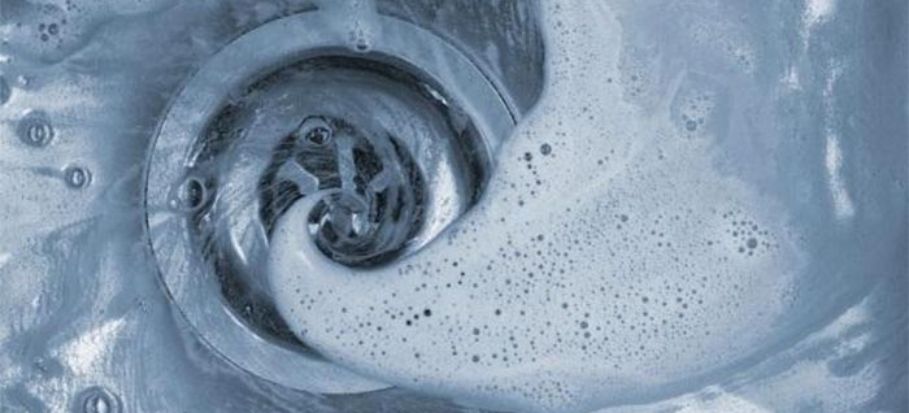House Drainage System Explained [Simple Beginner’s Guide]

To avoid many of the common plumbing-related issues, such as burst pipes, a leak under the sink, blocked drain and clogged toilets, you must first understand a bit more about the standard house drainage system.
Table of Contents
What is Drainage?
The drainage system’s most important feature is to carry away used water to the sewage system. If you ever wondered what is drainage, the simplest way to remember it is like all the used water leaving your property through the piping.
It is important to understand that your drains work by gravity only. The closer to a vertical pipe your drainage system is, the faster and easier it will flow away. As this is often difficult to achieve in standard household architecture, most drain pipes are at an angle to keep the used water flowing to the sewage constantly.
A horizontal drain pipe usually gets blocked by soap and grease residues and causes issues, such as slower water drains and eventually build up to a blockage. What happens when your drain water reaches the public sewer is a whole other topic. Usually, your local authorities take care of everything that goes beyond the lateral drain.
What is Plumbing?
We have access to water around our properties through the plumbing. But what is plumbing? It is usually divided into two subsystems. One subsystem brings freshwater from a mains water supply near our property, which is then regulated to our taps and water fixtures through a network of pipes. The other subsystem takes the wastewater away to the sewage plant.
All water coming into your property goes through a meter, which registers the amount you are using. With burst pipes, it is important to know where the main water stop valve is, and that usually is very close to the meter.
Foul Drainage Systems And Surface Water Drainage
Now that you are familiar with plumbing and drains, it is time to learn what foul water drainage is and how it differs from the surface water drainage system. In modern properties, they are usually divided into a distinct set of pipes each.
Foul drainage will transport the water coming from the bathrooms, kitchen sink, shower and your laundry away from your property. This water is considered wastewater and needs to be transported to your local sewage treatment plant. All the water coming to your property from the mains supply that is being used needs to go through your foul drains.
Surface water drainage is for all water around your property that is not connected to your house plumbing. That includes the rainwater collected by your gutters, your patio, sportsfields and driveway. Since it has not contaminated, it is not considered harmful and can be diverted to a soakaway, a river or a stream.
If you live in an old property, it is possible that they combine both systems in one, but it is best to keep them separate. Storm-water flowing to your foul drainage can lead to flooding and foul water flowing to your surface water drain may cause contamination of the streams it is taken to.
How Drainage System Works
It is easy to understand how the drainage system works. It functions entirely with the help of gravity and does not use any pressure to move water through your plumbing. All water appliances, all sinks and toilets within your house are connected with pipes.
When you flush or turn the tap on the wastewater goes first to a small pipe in your house and then connects to a larger sewer pipe under the road. This sewage then joins a network of municipal sewers which all go to a sewage treatment plant.
House Drainage Parts and Components
Being familiar with most of the parts of your drainage system can be crucial in times of need. Most drain parts and components are well hidden under our sink, behind walls or under floors, but knowing which is responsible for what may save you time, effort and potentially money.
- Fixture Drains – this is the visible part of your sink or shower drain that everybody is familiar with. It is open and often comes with some blocking mechanism.
- U-bends or P-traps – immediately after the fixture drains there is a p-trap, which is often a curved pipe, shaped in the letter „P” or „U“. It holds standing water and prevents sewage gasses from rising.
- Toilet trap – sometimes built-in, the toilet trap is like the p-trap in shape and function – it blocks sewage gasses.
- Clothes washer Standpipe – while most of your washing machine pipes may be hidden, the standpipe is often left exposed. The washing machine drain tube takes the water to your standpipe, which takes it to your sewage.
- Branch Drain lines – they run horizontally and connect fixture drain traps to main drain lines. They are often hidden behind the walls.
- Main drain line – hidden under your foundation slab or basement floor, the main drain line is connected to the municipal sewer line and carries all your home’s wastewater to it.
- Pipe shut-off – your stop valve is usually close to your water meter and must prevent flooding or water damage.
Common Drainage Problems You Should Know About
Most of your home drainage problems are easy to spot, and you can easily prevent them from turning into a massive water issue by being caught on time.
This is a list with some of the most common plumbing drainage problems:
- Clogged or sluggish drains – if your drain is blocked, sluggish or starts emitting bad smells, you must unclog it to avoid creating a more serious problem. It’s always better to know how to unblock your sink drains.
- Attic mildew – hot air from the bathroom fans or rising moisture to your attic can often cause mildew. This is easily fixed by improving the ventilation or moving some vent outlets outside of your home.
- Wet spots on the lawn – your natural soil and grass may cause water pooling. This can be avoided by repurposing your lawn to a small pond or a dry well as holding tanks for the excess water. Another solution would be to install a rain garden or French drain systems.
- Water pools on your driveway or walkways – to keep your walkways well-drained there you can install a catch basin to act as a surface drain. Changing your sidewalk to stepping stones with space between them where water can easily drain is another option.
- Overflowing gutters – if your gutters are overflowing, it is time to clean them. When not maintained properly your gutters become the home of fallen leaves and sometimes small animals. If your gutters are clean then the issue may be an undersized gutter, dislocated gutter pipes or cracks. This will require a professional’s help.
- Downpipe issues – if your downspout cannot handle all the rainwater, this can cause pressure on the foundation of your home or flood your basement. You must relieve it by installing gutter extensions to optimal areas of your garden with the help of professional drainage services in London.
Takeaways
- Many of the water-related issues can be avoided or significantly minimized by simply understanding your plumbing system and its parts and components.
- Regular flushing with hot water can usually prevent the most common drainage system problems, such as blocked sink drain.
- If you have not by now – locate your main shut off the water valve and the water meter next to it. If you fear any plumbing issue may be occurring, it is best to switch it off. Familiarize yourself with the exposed pipes in your home and try to deduce where the remaining are, in case of any emergencies. In severe cases of blocked drains, remember to call for a professional clearing of blocked drains.
House Drainage System Explained [Simple Beginner’s Guide]
Need help? Hire the London Property Service experts today by giving us a call on 020 3078 5920.




